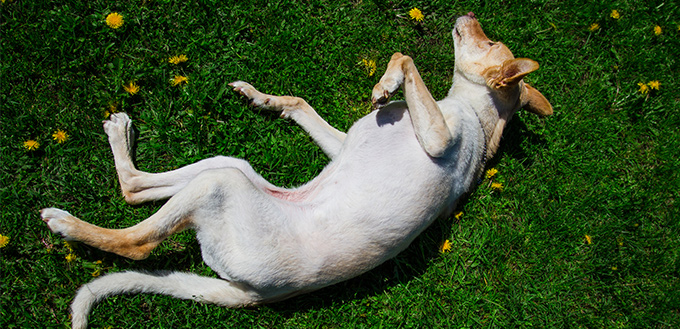Whether you are a new doggie parent or have had pups around as long as you can remember, there are all sorts of odd little thoughts and questions that can pop into your head. Just the other night, for example, I found myself wondering about my dogs’ belly buttons. Do they have them? What are they for? Where are they? The next day, I did a bit of research and discovered that they can be very important!
Finding the Belly Button
Some owners remember seeing their dogs belly button when they were first born. But many won’t have seen their birth, and after the first few weeks it can become difficult to see where the belly button is because it is very small and covered by hair. Even the shortest hair can mask the belly button if you don’t know what you are looking for.
With very short haired breeds, it is possible to distinguish a swirled pattern around the belly button that can help you find it. But for other breeds it can be difficult to see, so here is a quick step-by-step guide to finding it:
- Use your hands to find the belly button by feel
- Find their ribcage and move its centre
- Follow the ribcage down to the last rib
- Move to just below their ribcage and make sure you are still near the middle
- Often flanked by nipples, feel for a small line in the centre of their underside
- This should be their belly button.
- You might not find it immediately but keep at it – it is there somewhere!
I don’t know about your pets, but mine aren’t that keen on staying still long enough for me to find their belly button. So, a great tip to help you find it is to incorporate the search in one of their favourite activities – belly rubs! Belly rubs are a great chance to feel their underside for scrapes, bumps and other health concerns, as well as finding their belly button.
You might also be able to catch them at a calm, peaceful moment, such as when you watch television together. You might need to be careful so that you don’t shock them by suddenly grabbing at their underside, and they might not be in the best position for you to see what you are doing. My advice is to be patient and to start by just gently stroking them, and gradually move them into position so that you are able to gently rub their belly.

Belly Buttons in Mammals
Dogs aren’t the only animals that have belly buttons. Obviously, you probably know that humans have belly buttons, but you might not know that most other mammals also have them too. From cats to dolphins, all mammals have belly buttons, with the exception of marsupials and platypuses.
This is because all these mammals have belly buttons for the same reason – growing a baby. Just like human babies, when puppies are born from their mother, they are attached by an umbilical cord. This cord is how the baby is given nutrients and oxygen from the mother and has their waste, such as carbon dioxide, removed, via their mother.
Once a puppy, or a baby, is born, the umbilical cord needs to be cut, and this creates a scar. This scar is the belly button. This explains why marsupials and platypuses don’t have belly buttons as marsupials use pouches, which have umbilical cords that natural fall off, and platypuses lay eggs.
Puppy Bellies vs Baby Bellies
As mentioned above, a puppy’s belly button is a small, long slit. This is different to the human belly button which is usually a circle. This is simply because human babies need bigger umbilical cords, so when they are cut, they leave a larger mark.
Another key difference is that human babies have their umbilical cord clamped and then cut by a doctor. Whereas as Dr Margret Casal, Associate Professor of Medical Genetics at the University of Pennsylvania School of Veterinary Medicine, notes, after a dog gives birth the mother usually bites off and breaks the umbilical cord itself. After this, the cord is left to dry and it will naturally fall off between one and three days.
Important Health Concerns
A very healthy belly button should be a simple, small, innocuous slit at the end of their ribcage, in the middle of their underside. If this is the case with your dog, you have nothing to worry about. Keep an eye on it, just as you would any other part of their body, but generally, you should have no problems.
If your dog’s belly button is protruding, even a little bit, it might be the beginning of something more serious. At the very least, it is something that your vet should be aware of so that you can both monitor it. This is because it is likely to be protruding because it is an umbilical hernia.
According to veterinarian Dr Kim Smyth, an umbilical hernia occurs when a dog’s umbilicus, which is the medical term for the belly button, does not close properly. This means that the skin on the stomach which covers the umbilicus is the only line of defence between it and the external world. Normally, the umbilicus will heal with a layer of muscle beneath this layer of skin as another layer of defence. Abdominal fat and other parts of the stomach area can press against this skin and become trapped to create an ‘outie’.
Now don’t let this stress you out. It could still be nothing to worry about. There are two possibilities when it comes to umbilical hernias:
- Uncomplicated, small hernias: These are often nothing to worry about as they can be simple to fix, if they need to be fixed at all. Some hernias are so small that they cause no problems. Others may require a small amount of surgery to close the umbilicus muscles to prevent future problems. This is a very simple procedure that is often done at the same time as other simple, necessary, anaesthetic operations, such as neuter or spay surgeries.
- Complicated, large hernias: Occasionally, a large umbilical hernia can allow for the intestines to become trapped. This is much more serious as it can lead to oxygen deprivation for healthy cells and can be fatal. This dangerous form of hernia is often accompanied by a fever, and pain, and should be dealt with as soon as possible.
Your vet will often check your dogs belly button on their first visit as a puppy, so you may be aware of a very small umbilical hernia that they have had from birth. If you have been told that they have a small hernia, keep an eye on it for any changes, and bring them to the vet if you have any concerns. Similarly, if you have never been told, that your dog has a hernia, and you notice that they have an ‘outie’, it is better to be safe than sorry, so you should bring it to the attention of their vet.

Breeds and Hernias
It is possible for hernias to occur to any breed of dog, so get to know your best friend’s belly button so you will be aware of any changes. However, there are some breeds that are more at risk and if you have one of these, you should be particularly attentive. These breeds are:
It is most important to keep an eye on them for their first few months, as this is the time when they are most likely to develop a small, uncomplicated ‘outie’ which can be fixed early and easily.
Looking After Your Pooch
Ultimately, the best advice I can give you is suitable for most health situations in your pet’s life – monitor it and go to your vet if you have any doubts. But the good news is, this is quite easy task. You just need to give lots and lots of fun belly rubs. I’m sure your dog will appreciate it!
Sources:
- Stanley Coren PhD., Do Dogs Have Belly Buttons?, Psychology Today
- Rebecca Martin BVSc, Do Dogs Have Belly Buttons?, VetHelpDirect







